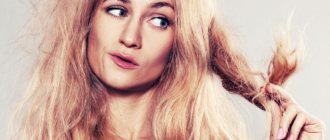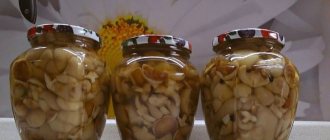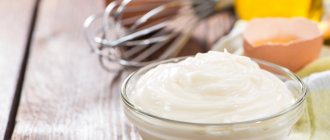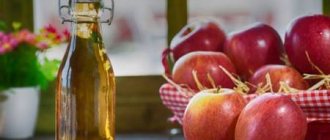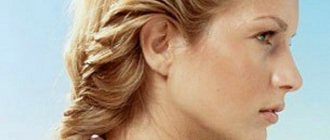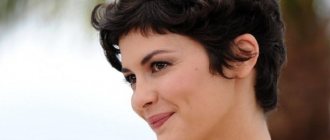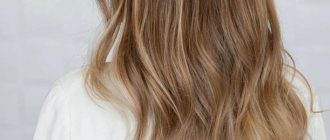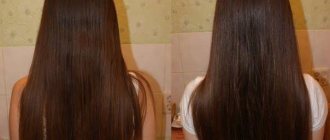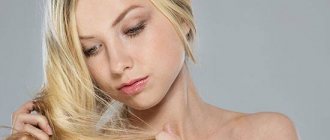Recipes for hair masks with apple cider vinegar
Mask for normal hair with honey
Mix:
- 1 glass of warm water;
- 2 tsp. apple cider vinegar;
- 2 tbsp. l. liquid honey.
Apply the mask to the scalp and along the entire length of the hair, wrap your head with cling film and a towel. Leave for 20–30 minutes. Wash off the composition with warm water and your usual shampoo. Repeat the mask every 10 days.
The mask improves blood circulation in the scalp and makes hair more manageable.
Mask for oily hair
Components:
- 3 tbsp. l. chopped apple;
- 2 tbsp. l. apple cider vinegar;
- 1/2 glass of water.
Mix the ingredients thoroughly until smooth, apply and rub into the roots of the hair, distribute over the entire length. Wrap your hair in cling film and a towel. Leave for 25–30 minutes. Wash off the composition with warm water and your usual shampoo. Repeat the procedure once a week.
Hair shine mask
Compound:
- 3 tbsp. l. apple cider vinegar;
- 2 chicken yolks;
- ½ glass of water.
Mix the ingredients, apply to the scalp and along the entire length of the hair, wrap the hair with cling film and a towel, leave for 30 minutes. Wash off the composition with warm water and your usual shampoo. Repeat the procedure every 10 days.
Hair treatment with herbs
To treat hair, chamomile, nettle, hops, plantain, horsetail, calendula, St. John's wort, coltsfoot are most often used. Herbs have the ability to strengthen hair, improve its structure, eliminate dandruff and prevent split ends. Regular use of herbs in hair care will make it more vibrant, shiny and silky. Herbs can be used in pure form or in combination with other medicinal plants.
Herbs for hair treatment are used in the form of infusions, as well as in their natural form, simply added to masks. Decoctions or infusions of herbs should be used warm and stored for no more than three days. It is very simple to prepare an infusion or decoction of herbs: 1 tbsp. pour a glass of boiling water over the herbs, bring to a boil over low heat or leave for 30 minutes. Use as a final rinse or as a base for therapeutic masks.
You can add honey, castor or burdock oil, egg yolk and other ingredients to the herbal mask. Keep the mask on for about 40 minutes and wash off with shampoo.
Rinse hair with apple cider vinegar
Features of rinsing with apple cider vinegar
- Before first use, perform an allergy test on the crook of your elbow.
- Do not rinse your hair with apple cider vinegar if you have a wound on your scalp.
- Apple cider vinegar can affect the color of dyed hair and the quality of the curl.
- For oily hair, the frequency of rinsing is no more than 1 time in 2 days, for normal hair - 1-2 times a week. If you usually wash your hair less often, you shouldn’t wash it more often for the sake of rinsing.
- Rinse already washed hair.
- Before use, heat the rinse composition to a pleasantly hot temperature.
- After rinsing with apple cider vinegar, do not wash your hair, just pat dry with a towel and dry without using a hair dryer.
Classic recipe for hair rinse with apple cider vinegar
Mix:
- 1 liter of warm boiled or filtered water;
- 1 tbsp. l. apple cider vinegar.
Rinse your hair after each shampoo.
This rinse makes hair manageable and softer.
About the product
The usual alcohol vinegar (6-9%) may be suitable for rinsing after washing your hair. To do this, dilute a tablespoon of vinegar in a liter of warm water and rinse your hair. After this procedure, you can wash off the remaining solution from your hair with running warm water. But you don't have to do this. The smell of vinegar does not last long on the hair. After the procedure, the hair becomes fluffier, easier to comb, and acquires a pleasant shine. However, for dry and brittle hair, such rinsing should not be done, as it dries the hair and can make it even drier.
Apple cider vinegar has lower acidity, so its use is more advisable. It can be added to rinse water in a volume of 100 grams per liter of water. It is worth recalling that the apple cider vinegar offered by the retail chain is synthetic.
Preparing the product at home is not difficult. You need to grate three ripe apples, add a glass of sugar, add hot boiled water so that the liquid covers the apple mass. Leave the mixture in an enamel pan for two weeks in a warm place and stir daily. Then, strain and leave the liquid in a glass container for another ten days in a warm place. As a result, the life-giving hair liquid is completely ready for use. It can be used not only as a hair remedy, but also as a seasoning in the preparation of various dishes. This is a healthy supplement and a beneficial environment for the digestive tract.
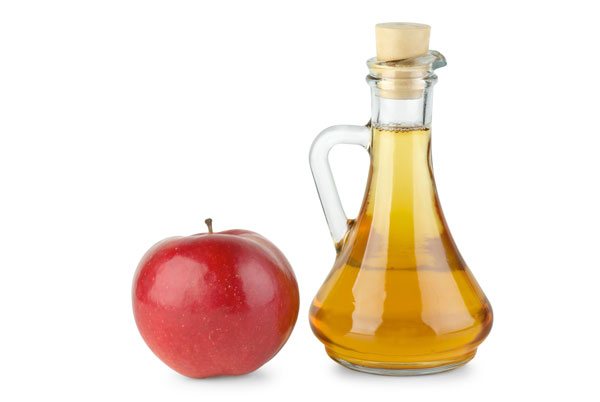
Wine vinegar has the same properties as apple cider vinegar. You can prepare it using the same method, using dry grape wine as a basis. For rinsing or preparing masks, it is better to use natural fruit, berry or wine vinegar, since the products on store shelves are mostly synthetic.
Let's sum it up
Regardless of what kind of hair you have and how long ago the problems with it began (split ends, lack of shine, loss), you can start rinsing your hair with apple cider vinegar. Reviews confirm that the result will not be long in coming. Within a few weeks you will notice a huge difference. At the same time, you can continue to use the usual balms and masks, or you can completely abandon them. Focus on the condition of your curls.
If you love your hair, you've most likely tried many healthy treatments on it. Some were immediately discarded due to their ineffectiveness or high cost, while others became an opportunity that helps maintain hair in good condition, which is very difficult in current conditions, with a very unsatisfactory environment.
For many women, vinegar has become a savior and panacea for many ills. This food industry product, which can also be produced at home, has proven to be effective and capable of restoring health, youth and shine to hair.
Properties of vinegar and its types
Vinegar is obtained from products that contain alcohol through the process of microbiological synthesis. To obtain it, acetic acid bacteria are used. There are two types:
- synthetic;
- natural.
Natural contains food acids. The artificial one is a concentrate with the smell of acetic acid.
The natural product is also divided into several types:
- wine (white and red, depending on the type of wine) – widely used in cooking;
- apple – very rich in useful substances, therefore it is actively used not only in cooking, but also for medicinal purposes;
- balsamic is an expensive product made from special grape varieties using complex techniques. Used in cooking to give dishes a refined aroma;
- malt - known mostly in England;
- Rice is the most commonly used in the countries of the eastern continent.
The synthetic product can be found in stores in the form of vinegar essence, which is very convenient to use when preserving food for the winter.
Many women, using vinegar to strengthen their hair, do not pay much attention to the chosen type and its characteristics. However, in order for the product to retain its beneficial qualities and be suitable for hair strengthening and treatment procedures, it is necessary to attach importance to what is purchased in the store and store what is purchased according to the rules.
Table vinegar should be clear, like a tear, while apple and wine vinegar will have a rich color. A high-quality balsamic should be viscous.
The product should be stored at a temperature of 5 to 15 °C in a tightly sealed glass container away from sunlight.
Vinegar proportions
But let's return to the topic of useful rinsing. It happens that in reviews you can read about the negative effect of vinegar on the hair structure. Such negative reviews are quite predictable. Alas, not everyone understands that more does not mean better. It is necessary to strictly observe the proportions that have been proven over centuries. Our great-grandmothers also knew that if you overdo it with vinegar when rinsing your hair, you can get the opposite effect: dry and brittle hair, not a small part of which remains on the comb when combing.
The proportions that must be observed are 1-2 tablespoons per liter of water. And no more! And we are talking about a 9% product. If the percentage is different, the proportions should be changed. Those who follow the rule don't have to litter the internet with complaints about the damage vinegar did to their hair, they will write exclusively about the benefits.
In order to enhance the beneficial effect, it is recommended to add infusions or decoctions of various herbs to the solution. The main recommendations are based on the properties of certain plants, so for brighter colors, brunettes are recommended to add rosemary to the prepared solution, while blondes are better off using chamomile. Sage will strengthen the hair roots, and nettle will remove dandruff from them. Adding any essential oils will make your hair look voluminous with a subtle sheen.
Beneficial properties of vinegar for hair
To avoid having to write negative reviews on forums, you need to approach the issue of choosing vinegar responsibly. Natural wine or apple are most suitable. But synthetic, high-quality tinted to look natural, can cause harm to hair. The only thing you can achieve from it is to strengthen the dye if the hair is dyed, but not the hair itself. The natural product is not only saturated with useful substances, such as minerals, trace elements, acids and vitamins, but also readily part with them, strengthening the hair and giving it shine.
The vinegar solution will help normalize the acid-base balance. And this will eliminate problems such as oily hair, itching, dandruff and hair loss. What is typical is that you can achieve a quick effect. Two to three weeks are enough for the hair to become unrecognizable. Vinegar will help restore their youth and pristine beauty.
It is worth noting that our grandmothers preferred vinegar for a reason. Soaps made from alkaline products are not ideal for the slightly acidic environment of the scalp. Shampoos had not yet been invented at that time. It was necessary to use improvised means, which turned out to be vinegar, thanks to which combing the lush long braids, which were the property of the majority of representatives of the fair half of humanity, turned from a difficult and even painful process into a pleasant one.
In addition to maintaining proportions, it is worth mentioning the regularity of rinsing. It is better to do it after each wash and monitor how the hair reacts to the procedure. This will help determine your individual need for the product. Some people believe that vinegar dries out hair, but this is a misconception.
A few words about recipes
The classic recipe is simple: one liter of water plus a tablespoon of vinegar. If you add a decoction, then one glass is recommended, if you add essential oil, then one or two drops. If you overdo it with vinegar, there will be no harm, but it may leave a sour smell on your hair. Essential oil will completely kill it.
You can make not only rinsing solutions, but also masks for oily or dry hair. For fatty ones, just mash the apple pulp of one apple and mix it with a tablespoon of vinegar. If your hair is long, you should increase the apple mass. It is recommended to leave on hair for at least 20 minutes.
If the hair, on the contrary, is dry, 1 teaspoon of vinegar 9%, one yolk and 1 teaspoon of castor oil will save the situation. In this case, you need to keep your hair under a plastic cap for at least 50 minutes.
If hair does not grow, add ten drops of sage oil to a glass of water mixed with a tablespoon of 9% vinegar. By replacing sage with a tablespoon of natural honey, you can get a strengthening mask. If the problem is dandruff, additional ingredients to 90% vinegar would be lemon juice, olive oil and an egg.
Our grandmothers composed hundreds of recipes, most of which have survived to this day. Vinegar, if it is natural, is useful. This invaluable product can only cause harm if it is used incorrectly.
Finally, I would like to note that vinegar is useful not only for hair. With its help you can cure a sore throat, relieve muscle pain, reduce fever and much more. An indispensable product that perfectly solves many household problems. For example, you can use it to get rid of weeds in your garden or remove sweat stains from clothes.
So what does vinegar bring us, benefit or harm? Only benefit.
Currently, a wide variety of ingredients are used to care for curls. Table vinegar for hair is one of the most popular products used by girls. The curls become silky, soft, and begin to shine. Moreover, this happens if you rinse them with vinegar at least once a week.
It is recommended to use vinegar if your curls are not growing well: you need to strengthen them
Methods of application
Vinegar has been used for beautiful hair for a long time. You can also care for your scallop using this product. This is easy to do:
- mix boiled water and vinegar in equal proportions, add five milliliters of lavender or rosemary ether;
- soak your comb in the solution overnight. This method cannot be used if the comb is made of wood;
- then rinse the comb thoroughly under running water.
After carrying out such manipulations, the plaque from the comb will disappear, and the hair will be easier to comb.
Rinsing hair with apple cider vinegar
This is the easiest way to give your hair the desired volume and shine, and eliminate excess oiliness. How to rinse your hair with vinegar? Optimal proportion: per 1 liter one tablespoon of vinegar. Don't add too much or you might get burned. Mode of application:
- after washing your hair, rinse your hair with a prepared solution of water and vinegar;
- You should not rinse the product off your curls; a slight apple scent will remain on them. But it will go away as soon as the hair dries.
After the procedure, you should dry your hair naturally. To obtain the desired effect, you should use the procedure no more than once every ten days. There is no need to worry about drying out your strands. If you have followed all the proportions, then after the first use your curls will become smooth, shiny, more manageable, and dandruff will begin to disappear.
Check out some interesting styling ideas for bob haircuts.
How to treat oily seborrhea of the head? Effective methods are described in this article.
Read here about how to use curler papers.
Another vinegar-based rinse option is adding a decoction of medicinal herbs. Ladies with different hair colors should use various other decoctions:
- brunettes. For a liter of water, take a glass of rosemary and nettle infusion. Rinsing with this product will emphasize the dark shade of the hair, give it shine, and strengthen the structure of the curl;
- blondes. Decoctions of chamomile and linden will suit you. The proportions are the same as for brunettes. You can only add a couple of drops of lavender ether to the rinse. After washing, the curls will acquire a pleasant aroma, the color will remain the same, no darkening is predicted.
READ ALSO: Natural protein for hair - collagen: what is it? Principle of action, collagenation in the salon and at home, useful products
Useful and effective mask recipes
Based on the product, you can make useful hair masks with apple cider vinegar that combat various hair problems. Below are recipes for the most effective and efficient masks:
- anti-dandruff. Mix vinegar and water in equal quantities. Generously lubricate the epidermis of the head with the prepared mixture; rub in thoroughly with your fingertips. Wrap your head in polyethylene and wrap it in a warm towel. After half an hour, rinse the solution from your hair with shampoo. After the procedure, apply hair conditioner to your hair;
- strengthening brittle, lifeless hairs . Dissolve a spoonful of honey in 100 ml of water, add 35 ml of vinegar. Lubricate your curls along the entire length with this product, do not rinse for half an hour. To enhance the effect, you should put a special cap and a warm towel on your head;
- nutrient mixture (suitable for dry hair types). Mix castor and burdock oils slightly heated in a water bath (take 30 ml of each), add one mashed egg yolk, 25 ml of apple cider vinegar. Mix all the ingredients, distribute over the hair, and use a comb to distribute along the entire length of the strands. Be sure to warm your head and wash off after 45 minutes;
- restoration of damaged hair . Mix 50 ml of jojoba or olive oil, add one beaten chicken egg, 25 ml of vinegar, two tablespoons of liquid honey. Mix all ingredients, heat the oil in advance. Rub the resulting mass into the base of the hair roots. With the help of such manipulations, the damaged scales of the curls will close, gain strength and shine, and become much stronger. It is necessary to wrap your head; keep it for about 60 minutes;
- treating oily hair. Depending on the length of your hair, take the required number of apples (2–3 pieces) and grate them. Add 30 ml of apple cider vinegar to the fruit pulp. We lubricate the epidermis of the head with the resulting mass, lubricate the roots of the hairs; there is no need to distribute it over all strands. Wrap your head, rinse after 25 minutes;
- against brittle hairs. Chop a small head of onion, add 150 ml of full-fat kefir, 30 ml of honey and vinegar. This mass on the hair activates processes in the follicle and helps nutrients get there. Accordingly, curls become strong, grow faster, and fragility disappears. Wrap your head up and wash your hair with shampoo after 35 minutes;
- fight against split ends. For two tablespoons of coconut oil, take one tablespoon of almond oil, dilute the mixture with 25 ml of vinegar and one dessert spoon of liquid honey. Lubricate the ends of your curls with this mixture and leave for one hour. Then rinse your hair with a decoction of chamomile, calendula or nettle. Thanks to these actions, you will get rid of split ends in 3 weeks.
You can take care of your hair not only with masks and rinsing. You can conduct aroma combing sessions. The essence of the action is to prepare such a solution: one tablespoon of burdock and castor oils per 30 ml of vinegar. Coat your comb with this mixture and comb your curls with it every day. Within a week, you will be pleasantly pleased with the results: your hair is shiny, silky, there is no dandruff, and it smells nice.
Video about the properties and uses of apple cider vinegar:
Cooking at home
You can buy vinegar at any supermarket or grocery store for a reasonable price. One package will last you a long time. You can also make the product yourself at home. You know exactly the composition, you will be 100% sure of the quality of the product. Recipe:
How to make apple cider vinegar at home? To prepare an excellent quality unrefined product, you should choose ripe apples. Even if there is a worm in them, it doesn’t matter, this is a sure sign that the fruits grew without chemicals.
READ ALSO: A useful gift from an overseas fruit for hair - coconut milk: benefits and harms, a recipe for laminating curls and all the secrets of use
- Grind fresh apples until mushy. This can be done using a blender or grater, the latter option takes a lot of time and effort. Therefore, use a mechanical device.
- For a two-liter jar you should take about half a kilo of apples.
- Place the finished crushed fruits in a glass container, fill with water (not completely, leave 2 cm from the top).
- Add liquid honey there, melted in a water bath, and half a tablespoon of dry yeast.
- The jar should be covered with a cloth rag and tied tightly with an elastic band.
- Place the product in a dark place, but not cool, for 7–10 days. It is recommended to stir the mixture every three days.
- After the required amount of time has passed, the vinegar should be filtered. Pour the liquid into a glass container, add 50 ml of honey for each liter of vinegar. Leave in a dark place.
- After 5–6 weeks the product is ready. Store it in a glass, opaque container. A good product should have a light brown color and a slight foam. This foam is also used for medicinal purposes.
Description and use of IV Rocher raspberry vinegar for hair
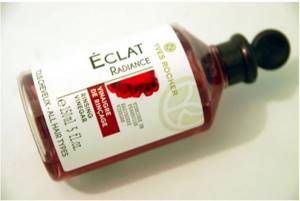
Yves Rocher raspberry vinegar is not harmful to health
The product from the French manufacturer Yves Rocher is available in 400 and 150 ml. There is no dispenser, but this does not affect the effectiveness in any way. Some complain that it is not very convenient. When used correctly, the product is used economically. It is non-toxic and does not have a negative impact on human health or the environment. The product has been tested and contains 98% natural ingredients. In addition to its softening properties, learn how to treat your hair with vinegar for lice and nits.
For a description of the product, see the video:
Some people think that the price is high - you will have to pay 300 rubles for a small bottle, 500 for a large bottle. Taking a large volume is much more economical.
Methods of use
There are 2 options for using raspberry vinegar. Let's look at each separately and step by step.
Method 1
- Measure out a tablespoon of vinegar.
- Dilute in 1 liter of water.
- Rinse clean hair with the solution.
- Do not rinse, wrap in a towel and dry.
Method 2
- Take 5 ml (1 cap) raspberry vinegar.
- Apply it to your hair from roots to ends.
- Massage for 3 minutes.
- Rinse with water.
Try 2 methods and choose the one you like. They say that after applying the pure solution, the hair will become voluminous. See what to do if you get a burn from vinegar.
